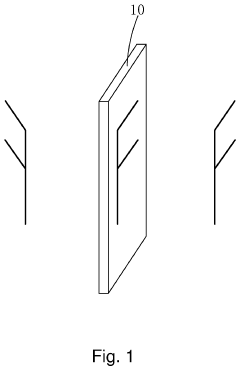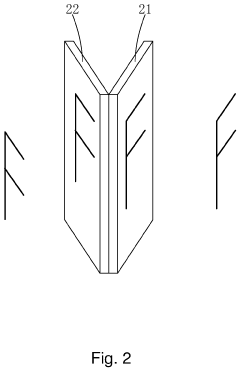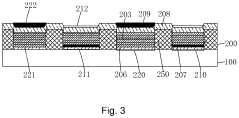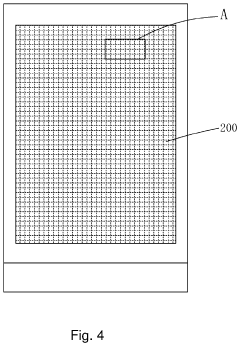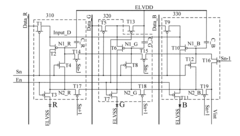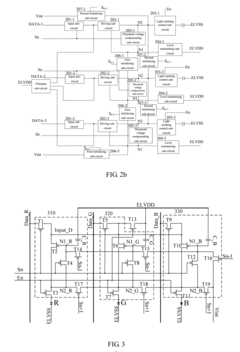How AMOLED ensures color accuracy under various angles?
JUL 17, 20259 MIN READ
Generate Your Research Report Instantly with AI Agent
Patsnap Eureka helps you evaluate technical feasibility & market potential.
AMOLED Color Accuracy Background and Objectives
AMOLED (Active-Matrix Organic Light-Emitting Diode) technology has revolutionized display systems, offering superior color reproduction and contrast ratios compared to traditional LCD screens. The evolution of AMOLED displays has been driven by the increasing demand for high-quality visual experiences across various devices, from smartphones to large-format televisions.
The primary objective in AMOLED color accuracy research is to maintain consistent and true-to-life color representation across different viewing angles. This challenge arises from the inherent properties of OLED materials and the complex interplay between light emission, color filters, and human perception.
Historically, AMOLED displays have struggled with color shift issues, particularly when viewed off-axis. This phenomenon, known as angular color shift, can result in perceived changes in hue, saturation, and brightness as the viewing angle changes. The root cause lies in the different emission characteristics of red, green, and blue OLED sub-pixels, which can lead to imbalanced color mixing at oblique angles.
Recent technological advancements have focused on mitigating these issues through various approaches. These include optimizing OLED material compositions, implementing advanced color management algorithms, and developing novel pixel structures. The goal is to achieve a wider color gamut while maintaining accuracy across a broad range of viewing angles.
One significant trend in AMOLED technology is the pursuit of higher pixel densities and more precise sub-pixel arrangements. This not only improves overall image sharpness but also allows for finer control over color reproduction. Additionally, the integration of advanced color management systems directly into display hardware has enabled real-time adjustments to compensate for viewing angle-induced color shifts.
The market demand for improved color accuracy in AMOLED displays is driven by several factors. Professional users in fields such as graphic design, video editing, and medical imaging require displays that can faithfully reproduce colors under various viewing conditions. Moreover, the consumer market increasingly values high-quality displays in mobile devices and televisions, where accurate color reproduction enhances the overall user experience.
As we look towards future developments, the challenge of ensuring color accuracy under various viewing angles remains a key focus area for AMOLED technology. Researchers and manufacturers are exploring innovative solutions, including the use of quantum dot materials, micro-LED integration, and advanced optical films to further enhance color stability and viewing angle performance.
The primary objective in AMOLED color accuracy research is to maintain consistent and true-to-life color representation across different viewing angles. This challenge arises from the inherent properties of OLED materials and the complex interplay between light emission, color filters, and human perception.
Historically, AMOLED displays have struggled with color shift issues, particularly when viewed off-axis. This phenomenon, known as angular color shift, can result in perceived changes in hue, saturation, and brightness as the viewing angle changes. The root cause lies in the different emission characteristics of red, green, and blue OLED sub-pixels, which can lead to imbalanced color mixing at oblique angles.
Recent technological advancements have focused on mitigating these issues through various approaches. These include optimizing OLED material compositions, implementing advanced color management algorithms, and developing novel pixel structures. The goal is to achieve a wider color gamut while maintaining accuracy across a broad range of viewing angles.
One significant trend in AMOLED technology is the pursuit of higher pixel densities and more precise sub-pixel arrangements. This not only improves overall image sharpness but also allows for finer control over color reproduction. Additionally, the integration of advanced color management systems directly into display hardware has enabled real-time adjustments to compensate for viewing angle-induced color shifts.
The market demand for improved color accuracy in AMOLED displays is driven by several factors. Professional users in fields such as graphic design, video editing, and medical imaging require displays that can faithfully reproduce colors under various viewing conditions. Moreover, the consumer market increasingly values high-quality displays in mobile devices and televisions, where accurate color reproduction enhances the overall user experience.
As we look towards future developments, the challenge of ensuring color accuracy under various viewing angles remains a key focus area for AMOLED technology. Researchers and manufacturers are exploring innovative solutions, including the use of quantum dot materials, micro-LED integration, and advanced optical films to further enhance color stability and viewing angle performance.
Market Demand for Wide Viewing Angle Displays
The demand for wide viewing angle displays has been steadily increasing across various market segments, driven by the growing need for high-quality visual experiences in both consumer and professional applications. In the consumer electronics sector, smartphones and tablets have become primary devices for content consumption, making wide viewing angle displays a crucial feature for manufacturers to differentiate their products. Users expect consistent color accuracy and image quality when viewing their devices from different angles, whether sharing content with friends or using their devices in various positions.
Television and monitor markets have also seen a significant shift towards wide viewing angle technologies. As living spaces become more open and flexible, consumers desire displays that maintain image quality when viewed from different parts of a room. This trend has pushed manufacturers to invest heavily in technologies like AMOLED and IPS, which offer superior viewing angles compared to traditional LCD panels.
In the automotive industry, the integration of large, curved displays in vehicle interiors has created a new demand for wide viewing angle technologies. These displays need to maintain visibility and color accuracy for both the driver and passengers, regardless of their seating position. This requirement has led to increased adoption of AMOLED displays in high-end vehicles and is gradually trickling down to mid-range models.
The professional market, including fields such as graphic design, video editing, and medical imaging, has always demanded high color accuracy. However, the need for wide viewing angles has become more pronounced as collaborative work environments become more common. Professionals require displays that maintain color fidelity when viewed from different angles during team discussions or client presentations.
Market research indicates that the global wide viewing angle display market is expected to grow significantly in the coming years. Factors contributing to this growth include the increasing adoption of OLED technology, advancements in quantum dot displays, and the rising demand for high-quality visual experiences across various applications. The market is also being driven by the growing popularity of gaming monitors and the expansion of the e-sports industry, where consistent color reproduction and image quality at different viewing angles are essential for competitive gameplay.
As the demand for wide viewing angle displays continues to rise, manufacturers are investing in research and development to improve existing technologies and explore new solutions. This includes efforts to enhance the color accuracy of AMOLED displays at extreme viewing angles, develop more efficient and cost-effective production methods, and create hybrid technologies that combine the benefits of different display types. The ongoing competition in this space is likely to result in further innovations and improvements in wide viewing angle display technologies, ultimately benefiting consumers across various market segments.
Television and monitor markets have also seen a significant shift towards wide viewing angle technologies. As living spaces become more open and flexible, consumers desire displays that maintain image quality when viewed from different parts of a room. This trend has pushed manufacturers to invest heavily in technologies like AMOLED and IPS, which offer superior viewing angles compared to traditional LCD panels.
In the automotive industry, the integration of large, curved displays in vehicle interiors has created a new demand for wide viewing angle technologies. These displays need to maintain visibility and color accuracy for both the driver and passengers, regardless of their seating position. This requirement has led to increased adoption of AMOLED displays in high-end vehicles and is gradually trickling down to mid-range models.
The professional market, including fields such as graphic design, video editing, and medical imaging, has always demanded high color accuracy. However, the need for wide viewing angles has become more pronounced as collaborative work environments become more common. Professionals require displays that maintain color fidelity when viewed from different angles during team discussions or client presentations.
Market research indicates that the global wide viewing angle display market is expected to grow significantly in the coming years. Factors contributing to this growth include the increasing adoption of OLED technology, advancements in quantum dot displays, and the rising demand for high-quality visual experiences across various applications. The market is also being driven by the growing popularity of gaming monitors and the expansion of the e-sports industry, where consistent color reproduction and image quality at different viewing angles are essential for competitive gameplay.
As the demand for wide viewing angle displays continues to rise, manufacturers are investing in research and development to improve existing technologies and explore new solutions. This includes efforts to enhance the color accuracy of AMOLED displays at extreme viewing angles, develop more efficient and cost-effective production methods, and create hybrid technologies that combine the benefits of different display types. The ongoing competition in this space is likely to result in further innovations and improvements in wide viewing angle display technologies, ultimately benefiting consumers across various market segments.
AMOLED Color Shift Challenges and Current Solutions
AMOLED displays have revolutionized the mobile device industry with their vibrant colors and deep blacks. However, one of the persistent challenges faced by AMOLED technology is color shift at different viewing angles. This phenomenon occurs due to the inherent structure of OLED pixels and the way light is emitted from them.
The primary cause of color shift in AMOLED displays is the varying emission patterns of red, green, and blue subpixels. Each subpixel has a unique angular emission profile, leading to changes in color balance as the viewing angle changes. This results in perceived color variations, especially noticeable when viewing the display from off-center angles.
Another contributing factor is the microcavity effect within OLED pixels. The optical cavity formed between the reflective cathode and semi-transparent anode can cause wavelength-dependent interference, further exacerbating color shifts at different angles.
To address these challenges, display manufacturers have developed several solutions. One approach is the implementation of advanced optical films and polarizers. These films are designed to manipulate the light emission patterns, reducing the angular dependence of color output. By carefully engineering the optical properties of these films, manufacturers can achieve more consistent color reproduction across a wider range of viewing angles.
Another solution involves optimizing the OLED stack structure. By fine-tuning the thickness and composition of various layers within the OLED pixel, engineers can minimize the microcavity effect and improve the angular color stability. This often includes adjusting the electron transport layer (ETL) and hole transport layer (HTL) to achieve a more balanced light emission profile.
Color compensation algorithms have also been developed to dynamically adjust the display output based on the detected viewing angle. These algorithms use sensors to determine the viewer's position relative to the screen and apply real-time corrections to maintain color accuracy. While this approach can be effective, it requires additional hardware and processing power.
Some manufacturers have explored the use of quantum dot technology in conjunction with AMOLED displays. Quantum dots can help narrow the emission spectrum of each color, potentially reducing the angular dependence of color output. This hybrid approach combines the benefits of QLED and OLED technologies to achieve improved color stability.
Despite these advancements, achieving perfect color accuracy across all viewing angles remains a challenge. The trade-offs between color accuracy, power consumption, and manufacturing complexity continue to drive research and development in this field. As AMOLED technology evolves, we can expect to see further innovations addressing the color shift issue, ultimately leading to displays with even more consistent and accurate color reproduction.
The primary cause of color shift in AMOLED displays is the varying emission patterns of red, green, and blue subpixels. Each subpixel has a unique angular emission profile, leading to changes in color balance as the viewing angle changes. This results in perceived color variations, especially noticeable when viewing the display from off-center angles.
Another contributing factor is the microcavity effect within OLED pixels. The optical cavity formed between the reflective cathode and semi-transparent anode can cause wavelength-dependent interference, further exacerbating color shifts at different angles.
To address these challenges, display manufacturers have developed several solutions. One approach is the implementation of advanced optical films and polarizers. These films are designed to manipulate the light emission patterns, reducing the angular dependence of color output. By carefully engineering the optical properties of these films, manufacturers can achieve more consistent color reproduction across a wider range of viewing angles.
Another solution involves optimizing the OLED stack structure. By fine-tuning the thickness and composition of various layers within the OLED pixel, engineers can minimize the microcavity effect and improve the angular color stability. This often includes adjusting the electron transport layer (ETL) and hole transport layer (HTL) to achieve a more balanced light emission profile.
Color compensation algorithms have also been developed to dynamically adjust the display output based on the detected viewing angle. These algorithms use sensors to determine the viewer's position relative to the screen and apply real-time corrections to maintain color accuracy. While this approach can be effective, it requires additional hardware and processing power.
Some manufacturers have explored the use of quantum dot technology in conjunction with AMOLED displays. Quantum dots can help narrow the emission spectrum of each color, potentially reducing the angular dependence of color output. This hybrid approach combines the benefits of QLED and OLED technologies to achieve improved color stability.
Despite these advancements, achieving perfect color accuracy across all viewing angles remains a challenge. The trade-offs between color accuracy, power consumption, and manufacturing complexity continue to drive research and development in this field. As AMOLED technology evolves, we can expect to see further innovations addressing the color shift issue, ultimately leading to displays with even more consistent and accurate color reproduction.
Existing Color Compensation Techniques for AMOLED
01 Color compensation techniques
Various methods are employed to improve color accuracy in AMOLED displays. These include compensating for color shifts due to aging, temperature variations, and manufacturing inconsistencies. Advanced algorithms and hardware solutions are used to adjust color output dynamically, ensuring consistent and accurate color reproduction over the display's lifetime.- Color compensation techniques: Various methods are employed to compensate for color inaccuracies in AMOLED displays. These techniques involve adjusting the voltage or current applied to individual pixels, using color mapping algorithms, or implementing feedback systems to maintain consistent color output over time. Such compensation helps to improve overall color accuracy and uniformity across the display.
- Pixel structure optimization: Improving the pixel structure of AMOLED displays can enhance color accuracy. This includes optimizing the arrangement of sub-pixels, developing new materials for organic light-emitting layers, and implementing advanced pixel driving circuits. These improvements contribute to better color reproduction and reduced color shift across different viewing angles.
- Color gamut expansion: Techniques for expanding the color gamut of AMOLED displays are developed to improve color accuracy and vibrancy. This involves using new organic materials with improved spectral characteristics, implementing color filters, and developing advanced color processing algorithms. Expanded color gamut allows for more accurate representation of a wider range of colors.
- Adaptive brightness and color management: AMOLED displays implement adaptive brightness and color management systems to maintain color accuracy under varying ambient light conditions. These systems adjust the display's brightness and color temperature based on environmental factors, ensuring consistent color perception and improved accuracy in different lighting scenarios.
- Calibration and measurement techniques: Advanced calibration and measurement techniques are developed to improve and maintain color accuracy in AMOLED displays. These include in-line calibration during manufacturing, on-device color measurement sensors, and software-based calibration tools. Regular calibration helps compensate for variations in individual displays and ensures consistent color accuracy over the device's lifetime.
02 Pixel structure optimization
Enhancing color accuracy through improved pixel designs and layouts. This involves optimizing the arrangement of sub-pixels, adjusting their sizes, and implementing novel pixel structures to achieve better color representation and reduce color distortion. These advancements contribute to more precise and vibrant color reproduction in AMOLED displays.Expand Specific Solutions03 Color gamut expansion
Techniques to expand the color gamut of AMOLED displays, allowing for a wider range of colors to be accurately represented. This includes the development of new OLED materials, improved color filters, and advanced color processing algorithms to achieve more vivid and true-to-life colors while maintaining accuracy across the expanded color space.Expand Specific Solutions04 Calibration and measurement systems
Implementation of sophisticated calibration and measurement systems to ensure color accuracy in AMOLED displays. These systems involve precise color sensing technologies, automated calibration processes, and advanced software algorithms to adjust and maintain color accuracy throughout the manufacturing process and during the display's operational life.Expand Specific Solutions05 Power efficiency and color accuracy balance
Developing techniques to balance power efficiency with color accuracy in AMOLED displays. This involves optimizing the power consumption of individual pixels while maintaining high color fidelity, implementing adaptive brightness and color adjustment algorithms, and utilizing advanced power management systems to achieve both energy efficiency and accurate color reproduction.Expand Specific Solutions
Key Players in AMOLED Display Industry
The AMOLED color accuracy under various viewing angles market is in a mature growth stage, with a global market size expected to reach $50 billion by 2025. Technologically, it has progressed significantly, with major players like Samsung Display, BOE Technology, and LG Display leading innovations. These companies have developed advanced compensation algorithms and pixel structures to minimize color shifts at off-axis angles. Emerging players like CSOT and Visionox are also making strides, particularly in flexible AMOLED displays. The industry is seeing increased focus on quantum dot OLED technology to further enhance color accuracy and viewing angles, indicating ongoing technological evolution despite market maturity.
BOE Technology Group Co., Ltd.
Technical Solution: BOE's approach to ensuring AMOLED color accuracy across viewing angles involves a combination of hardware and software solutions. They utilize a high-precision color calibration process during manufacturing, which involves measuring and adjusting each display's color output at multiple angles[4]. BOE also implements an advanced color management algorithm that compensates for color shifts in real-time based on the detected viewing angle[5]. Their AMOLED panels feature a specialized pixel structure designed to minimize color distortion at extreme angles, incorporating sub-pixel arrangements that maintain color integrity even when viewed off-axis[6]. Furthermore, BOE employs a multi-layer OLED stack with optimized organic materials to enhance color stability and reduce angular dependency[7].
Strengths: Comprehensive color calibration process and advanced color management algorithms. Weaknesses: Relatively newer to AMOLED production compared to some competitors, potentially leading to lower yield rates.
Samsung Display Co., Ltd.
Technical Solution: Samsung Display employs advanced AMOLED technology to ensure color accuracy across various viewing angles. Their solution involves implementing a pixel compensation algorithm that adjusts the voltage applied to each sub-pixel based on the viewing angle[1]. This technique, combined with their proprietary organic materials, helps maintain consistent color representation. Additionally, Samsung utilizes a multi-layer OLED structure with specialized color filters to minimize color shift[2]. Their displays also incorporate real-time color management systems that dynamically adjust color output based on ambient light conditions and viewing angles, ensuring optimal color accuracy in diverse environments[3].
Strengths: Industry-leading AMOLED technology, proprietary materials, and advanced color management systems. Weaknesses: Higher production costs and potential for screen burn-in over extended periods.
Core Innovations in AMOLED Viewing Angle Compensation
Amoled double-side display
PatentActiveUS20200219957A1
Innovation
- An AMOLED double-sided display design featuring a substrate with alternating top-emitting and bottom-emitting OLED units, where the anode of top-emitting units is thicker and reflective, and the cathode of bottom-emitting units is thicker and light-transmissive, allowing for single IC control and eliminating mirrored images.
Pixel circuit, driving method applied to the pixel circuit, and array substrate
PatentActiveUS20180137817A1
Innovation
- A pixel circuit with integrated sub-pixel units, including input, driving, light emitting control, and level maintaining sub-circuits, along with a threshold voltage compensating sub-circuit, ensures that driving current is only applied during light emission, eliminating the impact of threshold voltage variations and reducing signal delays by sharing driving signals among sub-pixels.
Power Efficiency vs Color Accuracy Trade-offs
AMOLED displays face a significant challenge in balancing power efficiency with color accuracy, particularly when viewed from different angles. This trade-off is a critical consideration in display technology development, as manufacturers strive to create screens that offer both vibrant, accurate colors and extended battery life.
The power efficiency of AMOLED displays is one of their key advantages. Each pixel in an AMOLED screen emits its own light, allowing for selective pixel illumination. This feature enables deep blacks and high contrast ratios while consuming less power compared to traditional LCD screens. However, maintaining color accuracy across various viewing angles can compromise this power efficiency.
Color shift at off-axis viewing angles is a common issue in AMOLED displays. As the viewing angle changes, the perceived colors may appear distorted or less saturated. To compensate for this, manufacturers often implement color correction algorithms and optical films. These solutions, while effective in improving color accuracy, can lead to increased power consumption.
The use of advanced materials in AMOLED panels, such as phosphorescent organic compounds, has helped improve both power efficiency and color accuracy. These materials offer higher quantum efficiency, allowing for brighter displays with lower power requirements. However, the challenge lies in maintaining consistent performance across all colors and brightness levels.
Another approach to address this trade-off is the implementation of adaptive display technologies. These systems dynamically adjust the display's color and brightness based on ambient light conditions and viewing angles. While this can significantly improve perceived color accuracy, it requires additional processing power and can impact overall device battery life.
The development of more efficient color filters and pixel structures also plays a crucial role in balancing power efficiency and color accuracy. Innovations in this area aim to reduce light loss and improve color purity without increasing power consumption. However, these advancements often come with increased manufacturing complexity and costs.
In conclusion, the trade-off between power efficiency and color accuracy in AMOLED displays remains a complex challenge. As technology progresses, manufacturers continue to explore innovative solutions that can optimize both aspects without significant compromises. The ongoing research in materials science, display algorithms, and manufacturing processes holds promise for future AMOLED displays that can deliver exceptional color accuracy across viewing angles while maintaining superior power efficiency.
The power efficiency of AMOLED displays is one of their key advantages. Each pixel in an AMOLED screen emits its own light, allowing for selective pixel illumination. This feature enables deep blacks and high contrast ratios while consuming less power compared to traditional LCD screens. However, maintaining color accuracy across various viewing angles can compromise this power efficiency.
Color shift at off-axis viewing angles is a common issue in AMOLED displays. As the viewing angle changes, the perceived colors may appear distorted or less saturated. To compensate for this, manufacturers often implement color correction algorithms and optical films. These solutions, while effective in improving color accuracy, can lead to increased power consumption.
The use of advanced materials in AMOLED panels, such as phosphorescent organic compounds, has helped improve both power efficiency and color accuracy. These materials offer higher quantum efficiency, allowing for brighter displays with lower power requirements. However, the challenge lies in maintaining consistent performance across all colors and brightness levels.
Another approach to address this trade-off is the implementation of adaptive display technologies. These systems dynamically adjust the display's color and brightness based on ambient light conditions and viewing angles. While this can significantly improve perceived color accuracy, it requires additional processing power and can impact overall device battery life.
The development of more efficient color filters and pixel structures also plays a crucial role in balancing power efficiency and color accuracy. Innovations in this area aim to reduce light loss and improve color purity without increasing power consumption. However, these advancements often come with increased manufacturing complexity and costs.
In conclusion, the trade-off between power efficiency and color accuracy in AMOLED displays remains a complex challenge. As technology progresses, manufacturers continue to explore innovative solutions that can optimize both aspects without significant compromises. The ongoing research in materials science, display algorithms, and manufacturing processes holds promise for future AMOLED displays that can deliver exceptional color accuracy across viewing angles while maintaining superior power efficiency.
AMOLED Manufacturing Process Improvements
AMOLED manufacturing processes have undergone significant improvements to enhance color accuracy across various viewing angles. One key advancement is the implementation of advanced pixel structures. Manufacturers have developed sophisticated sub-pixel arrangements that minimize color shift when viewed from different angles. These structures often incorporate additional sub-pixels or modified layouts to maintain consistent color representation.
Another crucial improvement lies in the development of advanced organic materials. Researchers have engineered new OLED compounds with improved molecular structures, resulting in more stable and uniform light emission. These materials exhibit reduced degradation over time and maintain consistent color output even when subjected to different viewing angles.
The integration of advanced color filters has also played a vital role in enhancing color accuracy. Manufacturers have developed high-precision deposition techniques to apply color filters with greater uniformity and precision. This ensures that each sub-pixel accurately reproduces its intended color, regardless of the viewing angle.
Advancements in thin-film transistor (TFT) technology have further contributed to improved color accuracy. The development of low-temperature polycrystalline silicon (LTPS) and oxide TFTs has enabled more precise control over pixel activation and current flow. This results in more consistent brightness and color output across the entire display, even when viewed from extreme angles.
The implementation of advanced compensation algorithms has been another significant improvement. These algorithms dynamically adjust the voltage applied to each pixel based on the viewing angle, compensating for potential color shifts. By incorporating sensors and real-time processing, AMOLED displays can maintain color accuracy even as the viewer's position changes.
Manufacturers have also focused on enhancing the overall display structure to minimize internal reflections and light scattering. This includes the development of advanced polarizers, anti-reflection coatings, and optimized layer stacks. By reducing unwanted light interactions within the display, these improvements help maintain color consistency across different viewing angles.
Another crucial improvement lies in the development of advanced organic materials. Researchers have engineered new OLED compounds with improved molecular structures, resulting in more stable and uniform light emission. These materials exhibit reduced degradation over time and maintain consistent color output even when subjected to different viewing angles.
The integration of advanced color filters has also played a vital role in enhancing color accuracy. Manufacturers have developed high-precision deposition techniques to apply color filters with greater uniformity and precision. This ensures that each sub-pixel accurately reproduces its intended color, regardless of the viewing angle.
Advancements in thin-film transistor (TFT) technology have further contributed to improved color accuracy. The development of low-temperature polycrystalline silicon (LTPS) and oxide TFTs has enabled more precise control over pixel activation and current flow. This results in more consistent brightness and color output across the entire display, even when viewed from extreme angles.
The implementation of advanced compensation algorithms has been another significant improvement. These algorithms dynamically adjust the voltage applied to each pixel based on the viewing angle, compensating for potential color shifts. By incorporating sensors and real-time processing, AMOLED displays can maintain color accuracy even as the viewer's position changes.
Manufacturers have also focused on enhancing the overall display structure to minimize internal reflections and light scattering. This includes the development of advanced polarizers, anti-reflection coatings, and optimized layer stacks. By reducing unwanted light interactions within the display, these improvements help maintain color consistency across different viewing angles.
Unlock deeper insights with Patsnap Eureka Quick Research — get a full tech report to explore trends and direct your research. Try now!
Generate Your Research Report Instantly with AI Agent
Supercharge your innovation with Patsnap Eureka AI Agent Platform!
